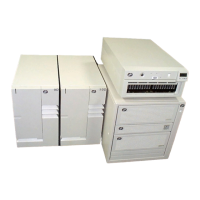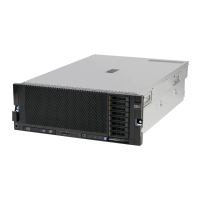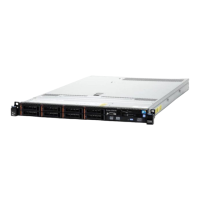Step 1540-14
There is at least one secondary I/O drawer attached to the CEC drawer. Perform the following steps to
isolate a faulty RIO cable.
Note: Before continuing, check the cabling from the CEC drawer to I/O drawer(s) to ensure that the
system is cabled correctly. Refer to “Cabling the CEC Drawer, Primary I/O Drawer, and Secondary
I/O Drawer(s)” on page 46 for valid configurations. Record the current cabling configuration and
then continue with the following steps.
1. Turn off the power.
2. At the CEC drawer, disconnect the cable connection at RIO port 0.
3. At the primary I/O drawer, disconnect the cable connection at RIO port 0. The RIO cable that was
connected to RIO port 0 should now be loose and can be removed.
4. At the CEC drawer, disconnect the cable connection at RIO port 1 and reconnect it to RIO port 0.
5. Follow the RIO cable you have connected to RIO port 0 of the CEC drawer back to a secondary I/O
drawer; disconnect the I/O drawer end (RIO port 1, note location) of the RIO cable and reconnect it to
the primary I/O drawer RIO port 0.
6. Verify that primary I/O drawer RIO port 0 is connected to the CEC drawer RIO port 0.
7. Turn on the power to boot standalone diagnostics from CD.
8. If the Please define the System Console screen is displayed, follow directions to select the system
console.
9. Use the Display Configuration and Resource List to list all attached devices and adapters (refer to the
RS/6000 and Eserver pSeries Diagnostic Information for Multiple Bus Systems if necessary).
10. Check that all attached devices and adapters are listed.
Did the Please define the System Console screen display and are all attached devices and adapters
listed?
NO Go to “Step 1540-15” on page 120.
YES The RIO cable that was removed in step 3 above is defective. Replace the RIO cable. Connect
the new RIO cable from CEC drawer RIO port 1 to the secondary I/O drawer RIO port 1 noted in
step 5 above. Reconfigure the system to its original condition. Go to ″MAP 0410: Repair
Checkout″ in the RS/6000 and Eserver pSeries Diagnostic Information for Multiple Bus Systems.
Chapter 3. Maintenance Analysis Procedures 119
